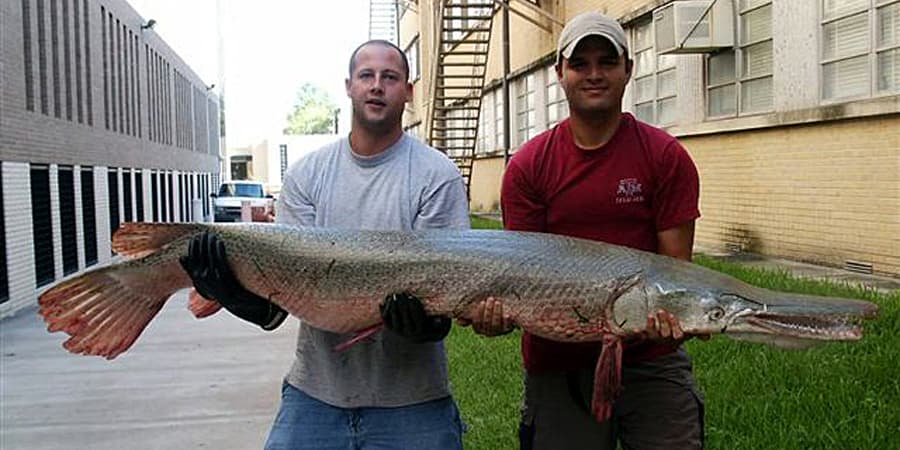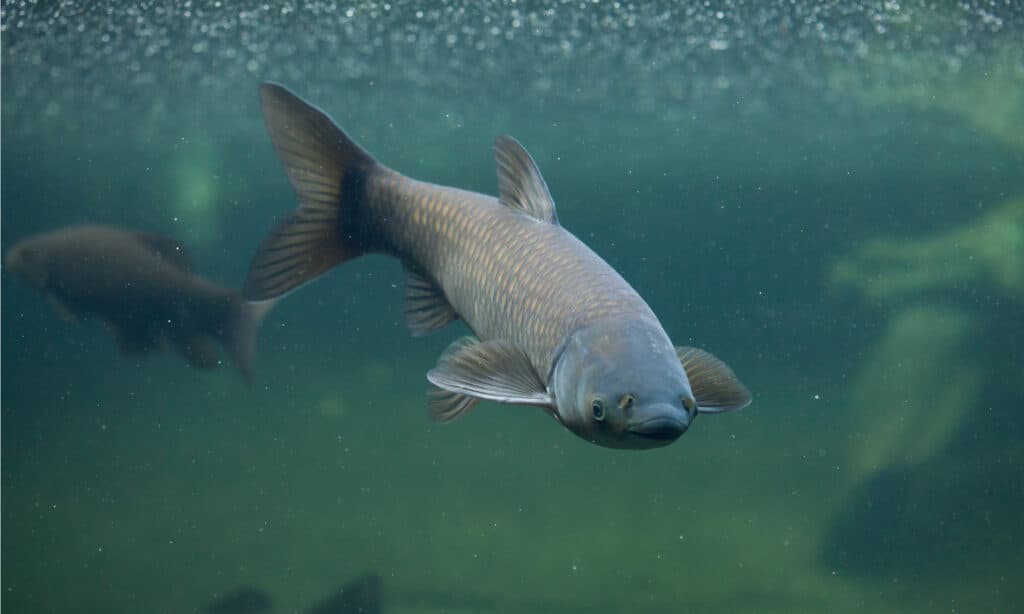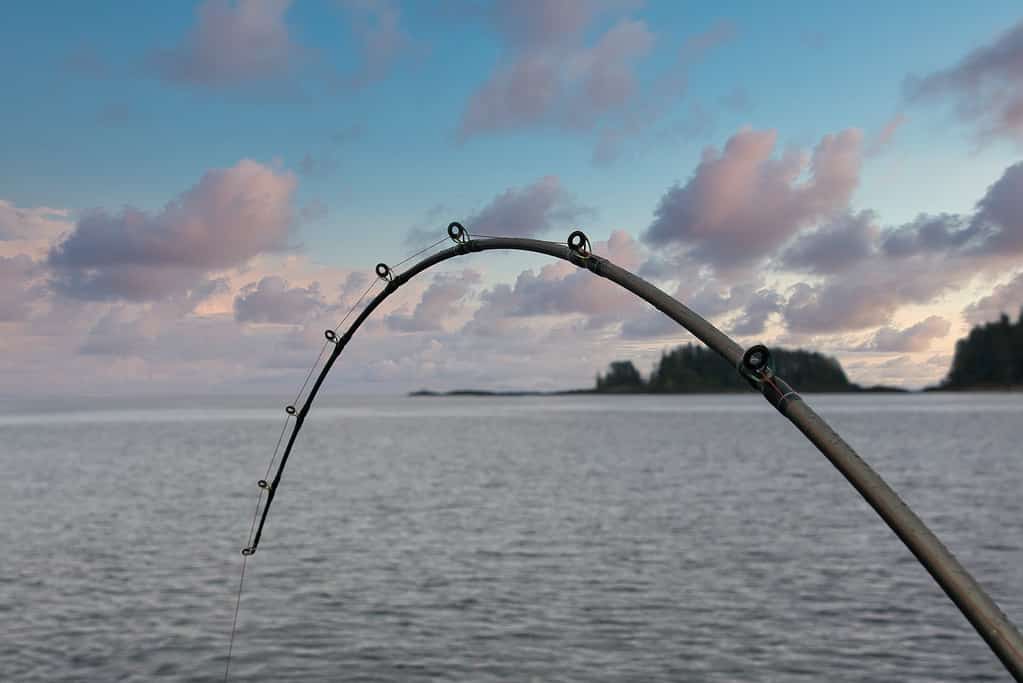Grass carp are a large freshwater Asian species of fish. Trophy sizes begin at 30 lbs, so you can see it’s a water goliath that takes some catching. Discover the largest grass carp ever caught in Illinois and other record-breaking grass carp from around the world.
The Largest Grass Carp Ever Caught in Illinois
The largest grass carp ever caught in Illinois weighed 66 lbs 8 oz. Mark S. Metzger hooked this colossal fish in Illinois’ Lake Petersburg on August 8, 1998.
In the bow fishing world, Lucas Guarnaccio shot a 78 lbs 8 oz monster grass carp in Lake Minear on June 5, 2014, destroying the previous record of 33 lbs 7 oz by a massive margin.

Illinois’ largest ever grass carp weighed a massive 66 lbs 8oz.
©Rostislav Stefanek/Shutterstock.com
World’s Largest Grass Carp Catches
Metzger’s water goliath grass carp was comparable in weight to a labrador dog, but how does it measure up to other record-breaking grass carp?
According to the International Game Fish Association, the largest grass carp ever caught to date weighed a humongous 87 lbs 10 oz. Bulgaria’s Piasuchik Dam produced this whopper in 2009.
In the United States, the largest grass carp catch was hooked by Kenneth Mosby Jr. on September 30, 2012, in Atchison State Fishing Lake, Kansas. This heavyweight grass carp topped the scales at an incredible 77 lbs and 75 oz.
Grass carp records are pretty vast across the world, too. In Britain, Little Moulsham Lake in Yateley, Hampshire, gave up a 56 lbs 2 oz giant, and France’s Etang de la Horre, a 76 lbs 8oz grass carp, emerged to fight the line.

The world’s largest grass carp catch weighed 87 lbs 10 oz.
©Keikona/Shutterstock.com
Other Record-Breaking Fish Caught in Illinois
Illinois is blessed with excellent game fish, and it’s produced some monsters over the years. Here’s some of Illinois’ record-breaking fish.
- Blue catfish: 124 lbs 4 oz hooked by Tim Pruitt on May 21, 2005, on the Mississippi River.
- Flathead catfish: 78 lbs snagged by Jody Harris on August 8, 1995, in Carlyle Lake.
- Carp: 51 lbs from Lake Hillcrest. Steve K. Davis hooked it on May 1, 1994.
- Lake trout: 38 lbs 4 oz hooked from Lake Michigan in 1999 by Theodore W Rullman.
Alligator gar is the largest native fish species in Illinois. This distinctively shaped fish reaches 300 lbs and 10 feet long. Experts think they live for decades, with grandpa alligator gars reaching 100 years old.
The last documented Illinois alligator gar catch happened in the Cache River in 1966. In the 1990s, Illinois declared alligator gar extinct, but a 2010 re-introduction program hopes to see them swimming in Illinois once again, preying on grass carp and other invasive carp species.

Alligator gar prey on grass carp. Illinois hopes to reintroduce alligator gar to its waters.
©Clinton & Charles Robertson / CC BY-SA 4.0 – License
Grass Carp Average Size
What makes Illinois’ largest-ever grass carp catch so incredible? An average-sized grass carp weighs in at 10-20 lbs, and trophy-sized catches begin at 30 lbs. Illinois’ record breakers weigh far more than the average grass carp.
Let’s find out a little more about grass carp and why they reach such epic proportions.
Grass Carp: Species Overview
Ctenopharyngodon idella is a freshwater fish species commonly known as the white amur. It was introduced to Europe and the United States in 1963 from Asia to manage vegetation in aquatic facilities. However, intentional and unintentional releases have allowed grass carp to enter most of the United States freshwater bodies where they thrive. By the 1970s, at least 40 states had established grass carp populations.
Today, this goliath fish thrives in 45 states, all but Alaska, Maine, Montana, Rhode Island, and Vermont, and they recently entered the Great Lakes Basin. Researchers believe invasive carp, including grass, silver, black, and bighead, threaten the Great Lakes ecosystem due to their voracious appetites.

Researchers believe grass carp threaten the Great Lakes. Asian carp have been detected in the Great Lakes Basin.
©Christopher Meder/Shutterstock.com
Appearance
We know this non-native fish is capable of reaching goliath proportions. It’s a large, powerful, and muscular fish with a slender cylinder-shaped body, flattish head, and upturned smiling mouth at the tip of its frame. Grass carp have no barbels, so it’s easy to distinguish them from barbel-whiskered common carp. Torpedo-formed grass carp glow deep bronze, which is readily spotted at the water’s surface in summer when they rise to warm up.
Grass carp juveniles grow at an incredible rate. Springtime youngsters more than double their length to 18 inches by fall. An average grass carp’s length is two to three feet long, maxing out at six and a half feet in extreme cases.
Habitat
Freshwater grass carp live at 68-86 degrees F in rivers, ponds, pools, backwaters, and lakes. Slow-moving or still water is preferable. Grass carp hide in aquatic vegetation, hugging banks, or submerged objects.
Large grass carp have few predators, but birds, snakes, and other fish eat the juveniles. Largemouth bass are capable of swallowing any fish under 12 inches in length.

Grass carp live in warm waterways, hiding in and eating aquatic vegetation.
©Vladimir Wrangel/Shutterstock.com
Diet
Adult grass carp can eat their body weight in aquatic vegetation each day. They’re especially keen on musk grass and hydrilla but graze on most submerged plants’ new growth. This is a problem in places because these large, hungry fish strip native vegetation bare, outcompeting native species and disrupting the ecosystem.
Juvenile grass carp vacuum up insects, zooplankton, and aquatic larvae, then branch out into tough vegetation as they mature. Adults develop comb-like teeth in their throats to grind up grind vegetation.
Spawning
Grass carp require moving water to spawn because their eggs die if they sink to the bottom. This means grass carp migrate to fast-moving waters in May and June to lay eggs that develop and hatch as they move downstream.
Amphibians, fish, birds, and crustaceans eat grass carp, eggs, and the fry that hatch out.
How to Catch Grass Carp
Powerful grass carp put up a fight, and anglers enjoy the ride. This strong fish requires heavy-duty tackle and patience.

Grass carp are fun to fish for. Use vegetation like tomatoes, beans, or watermelon as bait.
©Dudarev Mikhail/Shutterstock.com
Where to find grass carp
Grass carp hang out in weedy locations, along banks, and beneath structures like bridges in slow-moving or still water.
Plenty of Illinois’ ponds and lakes stock grass carp. Private lakes stock them to keep down vegetation levels. Ask permission first, but many waterway owners are pleased to have help getting the grass carp population under control, especially if they have completed their invasive plant-eating tasks.
Tips
Grass carp move fast, and they blend in pretty well with their environment. Plus, it’s a smart fish that easily spooks. Wear subtle clothing, move slowly, and take corn or cherry tomatoes to tempt them close. Grass carp like warm temperatures, so midday is a good time to locate targets.
Bait
As well as corn and cherry tomatoes, many anglers swear by watermelon, lima beans, cut damp lake weed, or even plain old bread and dog food. Cover the entire hook with your bait of choice.
Gear
Anglers like a 20-30 pound test line to ensure it’ll hold an epic grass carp’s weight, but some fishermen out for excitement chose a light 6-8 pound line to feel the fight.
In general, the preferred setup is a seven-foot fast action, medium heavy rod set with a medium spinning reel and medium gear ratio.
Cast gently and keep the dragline loose so a large grass carp can run without snapping it. Grass carp move fast, and they drop resisting bait in a flash.
Illinois’ Largest Grass Carp
Non-native grass carp patrol many Illinois lakes and ponds, searching out tasty vegetation and fast-moving streams to spawn in.
The largest grass carp ever hooked in Illinois weighed 66 lbs 8 ozs in 1998, and the largest bow shot weighed 78 lbs 8 ozs in 2014, so it’s clear Illinois is an established home to some pretty large grass carp. There’s everything to play for if you fancy yourself a record holder.

Heavyweight grass carp require tough tackle, such as a 20-30 lbs line.
©Darryl Brooks/Shutterstock.com
The photo featured at the top of this post is © Vladimir Wrangel/Shutterstock.com
Thank you for reading! Have some feedback for us? Contact the AZ Animals editorial team.






